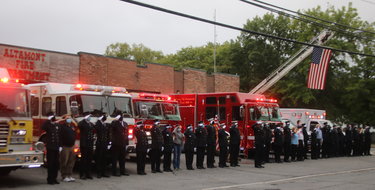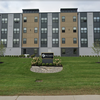Laying the foundation for a new Altamont firehouse
ALTAMONT — The Altamont Board of Trustees was recently presented with an extremely preliminary plan for a new Altamont Fire Department home.
Currently, the volunteer fire department shares space with the police department, village offices, court, and a community room at 115 Main St. in a building that was once a car dealership.
At their July 18 meeting, trustees were shown the early findings of a feasibility study commissioned last year to look at the possibility of a new, stand-alone Altamont firehouse that perhaps would be built at the site of the historic Doctor Crounse House, demolished by the town and village in 2021.
Mayor Kerry Dineen said during the meeting that the feasibility study came about “because there was this need, [Chief] Paul [Miller] brought it to the board.”
The mayor said, “I think we’ve been seeing this coming, with getting the last couple of trucks that we just don’t have enough room and this building is — it wouldn’t work to renovate. So this was the most cost-effective way to move forward, and this is not something that’s going to happen tomorrow [or] next year, it’s going take some time.”
Following up on Dineen’s comment, Trustee Nicholas Fahrenkopf said, “Actually, I’ll go back further. I think this probably started many years ago when we realized that we needed to make some repairs to the building. And we tried to do that and the costs that we were getting were significantly higher than we expected, so the prospect of doing any significant renovations is kind of a nightmare.”
He continued, “And then the renovations that we did were still a kind of a nightmare, trying to finish that work.”
Dan Woodside of CSArch told trustees on July 18, “The fire department certainly has outstripped the available space without being able to take over space, obviously from other departments within the building as well, which are already short on space.”
He said, “One of the biggest and most notable things, if you'’e in that station, in that space, the floor of the apparatus bay has cracked.”
Woodside said structural repairs were made but had been unsuccessful in resolving the problem. And with the weight of the fire trucks, it will continue to be an issue that “can’t get resolved, or has not been resolved.”
Another issue the department is facing, Woodside said, is that the National Fire Protection Code no longer allows gear lockers in truck bay areas. “Obviously, you’re grandfathered in with a station like this, but if we were to build it in a new building [or] renovate, they would have to be in a separate space.”
He told the trustees, “We have really found very quickly that the amount of dollars it would take to renovate a space like this into a station that really serves your purposes would probably far outweigh or come close to considering a new station.”
“So we have started to look at the possibility of building a new station on a new site.”
Location
The village can’t expand on the current site because it sits next to a floodplain in addition to backing up to one, Fahrenkopf told The Enterprise in a July 20 interview. And, even if it could, he noted how, when Westmere was building its current station 1741 Western Avenue, a temporary one had to be erected, an added cost.
So, the village began looking at what properties it owned that could house a new firehouse.
“We own the reservoir up in Knox,” Fahrenkopf said, which doesn’t make sense because of its distance from the village. “In the village … we own Bozenkill Park,” he said, which also doesn’t make sense. And then there’s the sewer treatment plant on Gun Club Road, but its facility is already taking up a lot of space.
Then the question was asked, “Are there other open lots?” Properties the village doesn’t own but would make sense for a new station.
There are two along Main Street, across from the former Crounse House and one at the corner of Thatcher Drive, and one next to the Agway on Prospect Terrace.
But the issue, Fahrenkopf said, is “we don’t own them; we don’t control them. And you don’t know what kind of bag of worms you’re going to find, especially where the service station was at the corner of Main Street and Thatcher Drive.
The village arrived at the site of the former Doctor Crounse House, which the town and village owned but did no repairs and so demolished it two years ago. The house stood on a nearly 3-acre plot of land, at the corner of Gun club Road and Route 146, which comes with its own set of issues, like that it’s jointly owned by the village and town of Guilderland, Fahrenkopf said. So that’s something that would have to be straightened out before a shovel could be placed in the ground.
Elizabeth Brutsch of CSArch told trustees on July 18 that a new station on the grounds of the former Crounse House would be a “whole self-service emergency service facility,” with room for the fire department as well as emergency medical services. The Altamont Rescue Squad currently operates from a two-bay garage less than a block away at 767 Route 146.
“A stepping-off point”
Brutsch said the new firehouse would have a drive-through apparatus bay doors, which “makes it easier for the firefighters to respond to calls and then bring those trucks back into the facility.”
There would also be separate gear locker storage and office space for officers.
“We have a kitchen and a meeting room for training,” she added.
Brutsch said, “We are working with Morton Building and other pre-engineered metal building manufacturers to provide a solution to the building that is both attractive — there are a lot of different aesthetic applications that we can apply to these buildings — while still maintaining a relatively low cost to the overall building.”
Resident Kate Provencher asked the board, “What are the next steps, and when does the public get to comment and have more information about this?”
Fahrenkopf told her, “I don’t think we have any next steps. Unfortunately, the village doesn’t have a couple million dollars lying around. We really don’t; we checked.”
He said, “The purpose of this engagement was to look at the current station. What would it take for it to last another 40, 50 years? And, “if that wasn’t an option or if that was going to be cost prohibitive, what would be the options for building a new station?”
He said, “And so what we’d like to be able to do is to use this plan as a stepping-off point — to continue the discussion.”
“Like a foundation for applying for funding,” Provencher said, an observation trustees agreed with.
Expensive patches
The current firehouse at 115 Main St. has received a few costly but only partial fixes recently.
Work on the front facade was needed because courses of brick along the bottom of the facade began to crumble. An engineer who came up with a plan to replace the front of the entire building said it should probably cost about $100,000, Fahrenkopf told The Enterprise on July 20. “We go out to bid and it came back at like $200,000,” Fahrenkopf said, so the village “re-bid it and it came back like $250,000.”
“That’s when we said, ‘All right, here’s what we really need to do: We really need to fix the bottom [course] because these are actually holding up all these other bricks,’” Fahrenkopf said, since the fear was the entire front facade could start to crumble.
In the meantime, other issues started to develop, chiefly the apparatus floor. The village hall, built as a car dealership, wasn’t built to hold a fire truck containing 3,000 gallons of water, Fahrenkopf said. Then the canopy over the door at the front of the building needed replacing.
Ultimately, for about $120,000, the village was able to replace the bottom 10 to 12 courses of brick, repoint most the remaining front facade, and replace with concrete eight to 10 feet of blacktop at the front of the building while also reinforcing and replacing perhaps a dozen or so square feet of concrete floor inside the building.
But, in addition to that work, the entire apparatus floor was supposed to be epoxied, new signs were supposed to go up, and new lighting was to be installed, he said, but the village “had some issues with our contractor,” and it never got done.
Fahrenkopf also cited columns that had been installed to hold up the roof about the time he joined the board as another example of short- to medium-term fix.
So, with some expensive Band-Aids affixed, village thinking turned to: “What are we going to do for the next 30, 40 years?” Fahrenkopf said. Because the current building will not “last for 40 years the way it is.”
So the village went looking elsewhere.
Finances
But then there’s the issue of paying for it all, not to mention the look of the building.
“We don’t have a lot of money,” Fahrenkopf said. “We don’t want to take on more debt. We’re still paying back our water and sewer debts,” he said, but “we also want it to look nice, right?”
The village could use a less inexpensive prefabricated building, he said, but “we would like it to look nice to fit in with the aesthetic of the village, right?”
On aesthetics, Fahrenkopf noted, “We gave the Stewart’s a hard time,” because it was offered a “cookie cutter” proposal, so the village should also be kept to a certain standard.
While acknowledging everything is still very, very preliminary, Fahrenkopf was asked about cost.
He said the feasibility consultants “really didn’t want to give me a figure,” but from his own research, he pegged a new building in the $5 million to $10 million range — noting how the pandemic, inflation, and supply-chain issues had increased the cost for a nice prefabricated building compared to Westmere’s “very nice masonry building” that went up about a decade ago, and came with an approximate $5 million price tag.
On top of it all, Fahrenkopf said, “We’re not ready to go.”
He said, “We don’t have money in the bank.”
“So, by the time we have saved or secured money,” costs will likely go up. “So it’s hard to kind of pin down,” he said of a definitive project cost. As for how the village would pay for a new firehouse, Fahrenkopf said it would likely take a combination of funding sources: savings, bonding, and grants.
With the foundational work of the feasibility study in hand, Fahrenkopf said it will “much easier to go to lawmakers or people and say, ‘This is what we want to do,’ versus ‘We want to [build] a firehouse, we have no idea what it’s going to look like, how much it’s going to cost, how much can you give us?’”
A comparative bargain
In comparison to other local fire districts, Altamont residents receive service for less. The Altamont Fire District covers approximately the western third of Guilderland.
The Altamont Fire Department has annual operating expenses of about $110,000, and puts away another $100,000 or so for new trucks. The “next closest fire district in the town is probably at least three or four times more than that,” Fahrenkopf said of Altamont’s operating budget. “So the value that people out here get from the fire department is very high.”
Fahrenkopf said one reason the Altamont Fire Department’s costs are so low but also why its facilities aren’t up to par with other departments is because the village board is “essentially the de facto fire commissioners, whereas all the other fire districts have their own fire commissioners.”
In other fire districts, budgets are put to an annual vote; for the Altamont Fire Department, it’s a line item in the village budget. In those annual fire district budget votes, typically only firefighters and family members vote, and whatever is on the ballot — like, say, a new firehouse — passes with ease.
“And I think if you look at other villages that do it as well — like Scotia has a really, really old firehouse as well,” Fahrenkopf said, noting it had taken years for Scotia to get the funding, over $7 million, in place for a new firehouse, which is currently being built.
As for any kind of timeline for the project, Fahrenkopf was hesitant to offer one. “I mean, literally, we just have those four pictures that we had,” he said of architectural drawings presented to the public at the July 18 board of trustees meeting. “That’s all we had.”
But he ultimately ballparked a figure of between five and 10 years.



